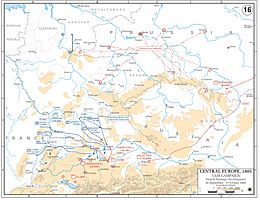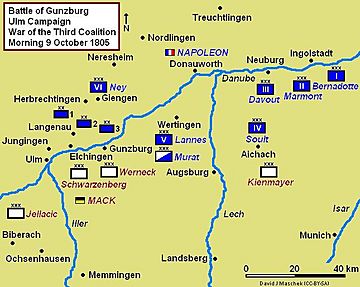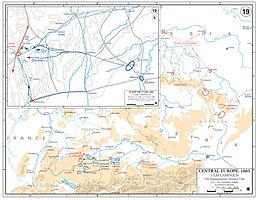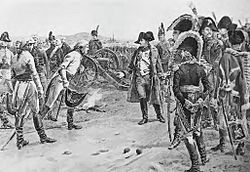Ulm campaign facts for kids
Quick facts for kids Ulm campaign |
|||||||
|---|---|---|---|---|---|---|---|
| Part of the War of the Third Coalition | |||||||
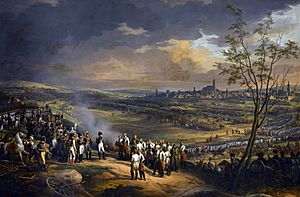 The Capitulation of Ulm, by Charles Thévenin |
|||||||
|
|||||||
| Belligerents | |||||||
| Commanders and leaders | |||||||
| Strength | |||||||
| 165,200-235,000 | 72,000 | ||||||
| Casualties and losses | |||||||
| 6,000 | 10,000 killed or wounded 60,000 captured |
||||||
The Ulm campaign was a series of clever military moves by France and Bavaria in 1805. Their goal was to surround and capture an Austrian army. This happened near and inside the city of Ulm in Germany.
The French army, called the Grande Armée, was led by Napoleon. It had about 210,000 soldiers. Napoleon wanted to defeat the Austrian army near the Danube River before Russian help could arrive. The French marched very quickly. This allowed Napoleon to make a huge circling move. On October 20, he trapped an Austrian army of 23,000 soldiers led by General Mack at Ulm. In total, 60,000 Austrian soldiers were captured during this campaign. Many people see this campaign as a brilliant military plan. It even influenced later war plans like the Schlieffen Plan.
Winning at Ulm did not end the war. A large Russian army was still near Vienna. The Russians moved northeast to wait for more troops and to join up with any remaining Austrian soldiers. The French followed them and captured Vienna on November 12. On December 2, the French won a major battle at Austerlitz. This forced Austria out of the war. The Treaty of Pressburg in December ended the Third Coalition. It made Napoleon's France the strongest power in Central Europe. This led to another war against Prussia and Russia the next year.
Why the War Started
Europe had been fighting in the French Revolutionary Wars since 1792. After five years, France defeated the First Coalition in 1797. A Second Coalition formed in 1798 but was also defeated by 1801. Only Britain remained an enemy of France.
In March 1802, France and Britain agreed to stop fighting with the Treaty of Amiens. For the first time in ten years, all of Europe was peaceful. But there were many problems between the two sides. Britain was unhappy about giving up colonial lands. France was angry that British troops had not left the island of Malta. The situation got worse when Napoleon sent troops to stop the Haitian Revolution. In May 1803, Britain declared war on France again.
Forming the Third Coalition
In December 1804, Britain and Sweden made an agreement. This led to the creation of the Third Coalition. British Prime Minister William Pitt the Younger worked hard in 1804 and 1805. He wanted to form a new group of countries against France. Britain and Russia had not trusted each other. But French mistakes brought them closer. By April 1805, they signed an alliance. Austria had lost to France twice recently. They wanted revenge and joined the coalition a few months later.
France Prepares for War
Before the Third Coalition formed, Napoleon had gathered an army. He called it the "Army of England." This army was meant to invade the British Isles. It was based in six camps at Boulogne in Northern France. Even though they never invaded Britain, these troops got excellent training. This training was very important for future battles.
These soldiers at Boulogne became the main part of what Napoleon called "La Grande Armée" ("The Great Army"). At first, the French army had about 200,000 men. They were organized into seven corps. A corps was a large group of soldiers. Each corps had about 36 to 40 cannon. They could fight on their own until other corps arrived. Napoleon also created a cavalry (horse soldiers) reserve of 22,000 riders. This included cuirassier (heavy cavalry) and dragoon (mounted infantry) divisions. By 1805, the Grande Armée grew to 350,000 soldiers. It was well-equipped and trained. Its officers, from sergeants to marshals, had experience from the recent wars.
Austria Prepares for War
Archduke Charles, Duke of Teschen, the Austrian Emperor's brother, began to reform the Austrian army in 1801. He tried to reduce the power of the Hofkriegsrat (Aulic Council). This council made military decisions. Charles was Austria's best commander. But he was not popular with the royal court. He lost influence when Austria decided to go to war with France against his advice.
Karl Mack became the new main commander. He changed how the infantry was organized just before the war. This sudden change meant officers did not have enough training. Austrian cavalry was considered the best in Europe. However, many cavalry units were spread out among infantry groups. This prevented them from having the strong impact of the French cavalry, which Napoleon could gather into large groups for battle.
The Ulm Campaign Begins
The Ulm campaign lasted for almost a month. The French army, led by Napoleon, kept striking the confused Austrians. It ended on October 20, when an entire Austrian army was lost.
Austrian Plans
General Mack thought Austria was safe by blocking the mountain passes. These were in the Black Forest area of Southern Germany. This area had seen a lot of fighting before. Mack believed there would be no fighting in central Germany. He decided to make Ulm the center of his defense. His plan was to hold off the French until the Russians, led by Kutuzov, could arrive. Ulm was protected by the strong Michelsberg heights. Mack thought the city was almost impossible to attack from outside.
However, the Aulic Council made a big mistake. They decided that Northern Italy would be the main battle area for Austria. Archduke Charles was given 95,000 soldiers. He was told to cross the Adige River. His first targets were Mantua, Peschiera, and Milan. The Austrians placed an army of 72,000 men at Ulm. Archduke Ferdinand was the official commander. But Mack was the real leader. Austrian plans also required Archduke John to secure the Tyrol with 23,000 troops. He was to connect his brother Charles's army with Ferdinand's army. Austria also sent small groups of soldiers to help the Swedish in Pomerania and the British in Naples. These were meant to confuse the French and spread out their forces.
French Plans

In earlier campaigns (1796 and 1800), Napoleon had focused on the Danube area. But Italy became more important both times. The Aulic Council thought Napoleon would attack Italy again. Napoleon had other ideas. He would send 210,000 French troops east from Boulogne. They would surround General Mack's Austrian army if it kept marching towards the Black Forest. Meanwhile, Marshal Murat would send cavalry (horse soldiers) through the Black Forest. This was to trick the Austrians into thinking the French were coming straight from west to east.
The main attack in Germany would be supported by French attacks elsewhere. Marshal Masséna would fight Charles in Italy with 50,000 men. St. Cyr would march to Naples with 20,000 men. Marshal Brune would guard Boulogne with 30,000 troops against a possible British invasion.
Murat and Bertrand scouted the area between Tyrol and the Main River. Savary, the chief planner, made detailed maps of roads between the Rhine and the Danube. The left side of the Grande Armée would move from Hanover and Utrecht. They would attack Württemberg. The right and center, troops from the Channel coast, would gather along the Middle Rhine near cities like Mannheim and Strasbourg. While Murat tricked the Austrians in the Black Forest, other French forces would invade central Germany. They would swing southeast to capture Augsburg. This move was meant to cut off Mack and his supply lines.
The French Attack
On September 22, Mack decided to hold the Iller River line at Ulm. In the last three days of September, the French began fast marches. These marches would place them behind the Austrian army. Mack believed the French would not go through Prussian land. But then he heard that Bernadotte's I Corps had marched through Prussian Ansbach. This made him make a critical choice: he decided to stay and defend Ulm. He did not retreat south, which might have saved most of his forces.
Napoleon did not have much accurate information about Mack's plans. He knew that Kienmayer's Corps was sent to Ingolstadt (east of the French). But his spies greatly exaggerated its size. On October 5, Napoleon ordered Ney to join Lannes, Soult, and Murat. They were to gather and cross the Danube at Donauwörth. However, the French encirclement was not complete enough. Kienmayer's troops managed to escape. The French corps did not all arrive at the same spot. Instead, they spread out on a long west-east line. Soult and Davout arrived early at Donauwörth. This made Kienmayer careful and he avoided them. Napoleon became more sure that the Austrians were gathered at Ulm. He ordered large parts of the French army to gather around Donauwörth. On October 6, three French infantry and cavalry corps headed to Donauwörth. They wanted to block Mack's escape route.
Realizing the danger, Mack decided to attack. On October 8, he ordered his army to gather around Günzburg. He hoped to strike at Napoleon's supply lines. Mack told Kienmayer to draw Napoleon further east towards Munich and Augsburg. Napoleon did not think Mack would cross the Danube and move away from his base. But he knew that taking the bridges at Günzburg would be a big advantage. To do this, Napoleon sent Ney's Corps to Günzburg. He did not know that most of the Austrian army was heading to the same place. On October 8, the campaign saw its first serious fight at Wertingen. It was between Auffenburg's troops and those of Murat and Lannes.
Battles at Wertingen and Günzburg
On October 7, Mack ordered Franz Xavier Auffenburg to take his division to Wertingen. This group had 5,000 foot soldiers and 400 horse soldiers. They were to prepare for the main Austrian advance from Ulm. Auffenburg was in a dangerous spot, unsure what to do and with little hope of help.
The first French troops to arrive were Murat's cavalry divisions. They began to attack the Austrian positions. Soon, Nicolas Oudinot's grenadiers joined them. They hoped to surround the Austrians from the northeast. Auffenburg tried to retreat southwest. But he was too slow. The Austrians lost almost all their force. Between 1,000 and 2,000 were captured. The Battle of Wertingen was an easy French victory.
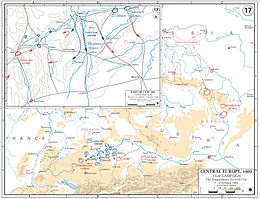
The fight at Wertingen convinced Mack to move his army on the left (north) bank of the Danube. He decided not to retreat directly east on the right bank. This meant the Austrian army had to cross to the north at Günzburg. On October 8, Ney was told to attack Ulm directly the next day. Ney sent Jean-Pierre Firmin Malher's 3rd Division to capture the Günzburg bridges over the Danube. In the Battle of Günzburg, a group from this division met some Tyrolean hunters. They captured 200 of them, including their commander, and two cannons.
The Austrians saw this and sent more troops to Günzburg. They added three infantry battalions and 20 cannons. Malher's division attacked the Austrian positions bravely, but they all failed. Mack then sent Ignaz Gyulai with seven infantry battalions and fourteen cavalry squadrons. They were to fix the destroyed bridges. But this force was attacked by the French 59th Infantry Regiment. Fierce fighting followed. The French finally managed to get a foothold on the right (south) bank of the Danube. While the Battle of Günzburg was happening, Ney sent Louis Henri Loison's 2nd Division to capture the Danube bridges at Elchingen. These were lightly defended by the Austrians. Having lost most of the Danube bridges, Mack marched his army back to Ulm. By October 10, Ney's corps had made good progress. Malher's 3rd division had crossed to the right (south) bank. Loison's 2nd division held Elchingen. And Pierre Dupont de l'Étang's 1st Division was heading towards Ulm.
Haslach-Jungingen and Elchingen Battles
The Austrian army was very discouraged. They arrived at Ulm early on October 10. Mack was thinking about what to do, and the Austrian army stayed still at Ulm until the 11th. Meanwhile, Napoleon had wrong ideas. He thought the Austrians were moving east or southeast. He also believed Ulm was not well-guarded. Ney realized this mistake. He wrote to Berthier that Ulm was actually much stronger than the French thought.
At this time, Napoleon became worried about the Russian threat to the east. So, Murat was given command of the right side of the army. This included Ney's and Lannes's corps. The French army was now split into two big groups. Ney, Lannes, and Murat were to the west, holding Mack. Soult, Davout, Bernadotte, and Auguste Marmont were to the east. They were guarding against any possible Russian and Austrian attacks.
On October 11, Ney pushed towards Ulm again. His 2nd and 3rd divisions were to march to the city along the right bank of the Danube. Dupont's division, with cavalry support, was to march directly to Ulm and capture the whole city. These orders were impossible. Ney still did not know that the entire Austrian army was in Ulm.
The 32nd Infantry Regiment from Dupont's division marched from Haslach towards Ulm. They met four Austrian regiments holding Boefingen. The 32nd attacked fiercely many times, but the Austrians held strong. The Austrians sent more cavalry and infantry to Ulm-Jungingen. They hoped to defeat Ney's corps by surrounding Dupont's force. Dupont realized what was happening. He launched a surprise attack on Jungingen. He captured at least 4,000 Austrians. New Austrian attacks pushed these forces back to Haslach. The French managed to hold Haslach. Dupont was eventually forced to retreat to Albeck. There, he joined Louis Baraguey d'Hilliers's foot dragoons.
The effects of the Battle of Haslach-Jungingen on Napoleon's plans are not fully clear. But the Emperor might have finally understood that most of the Austrian army was at Ulm. So, Napoleon sent Soult's and Marmont's corps towards the Iller River. This meant he now had four infantry and one cavalry corps to deal with Mack. Davout, Bernadotte, and the Bavarians were still guarding the area around Munich. Napoleon did not want to fight across rivers. He ordered his marshals to capture the important bridges around Ulm. He also started moving his forces north of Ulm. He expected a battle there, not just surrounding the city. These moves led to a fight at Elchingen on the 14th. Ney's forces advanced on Albeck.
At this point, the Austrian commanders were very confused. Ferdinand openly disagreed with Mack's leadership. He said Mack spent his days writing confusing orders. These orders made the Austrian army march back and forth. On October 13, Mack sent two groups out of Ulm. They were preparing to break out to the north. One group, led by Johann Sigismund Riesch, went towards Elchingen to secure the bridge. The other, led by Franz von Werneck, went north with most of the heavy artillery.
Ney quickly moved his corps forward to reconnect with Dupont, who was still north of the Danube. Ney led Loison's division to the south of Elchingen. They were on the right bank of the Danube and began the attack. Malher's division crossed the river further east. They moved west towards Riesch's position. The area was a partly wooded flood plain. It rose steeply to the hill town of Elchingen, which had a wide view. The French cleared Austrian guards from a bridge. Then, a regiment bravely attacked and captured the abbey at the top of the hill with bayonets. During the Battle of Elchingen, the Austrian cavalry was also defeated. Riesch's infantry fled towards Ulm. Ney was given the title Duke of Elchingen for his great victory.
The Battle of Ulm
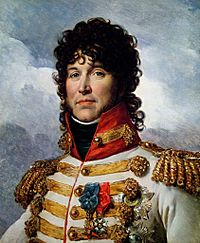
On October 13, Soult's IV Corps attacked Memmingen from the east. After a small fight, General-Major Karl Spangen von Uyternesse surrendered. He gave up 4,600 soldiers, eight guns, and nine flags. The Austrians had little ammunition. They were cut off from Ulm. They were also very discouraged by the confusion at their army headquarters.
More fighting happened on the 14th. Murat's forces joined Dupont at Albeck. They arrived just in time to push back an Austrian attack from Werneck. Together, Murat and Dupont defeated the Austrians to the north. They moved towards Heidenheim. By the night of the 14th, two French corps were near the Austrian camps at Michelsberg, just outside Ulm. Mack was now in a dangerous spot. There was no hope of escaping along the north bank. Marmont and the Imperial Guard were waiting outside Ulm to the south of the river. Soult was moving north from Memmingen. He was stopping the Austrians from escaping south to the Tyrol.
Problems continued with the Austrian command. Ferdinand ignored Mack's objections. He ordered all cavalry to leave Ulm, a total of 6,000 horse soldiers. But Murat chased them so well that only eleven groups joined Werneck at Heidenheim. Murat kept harassing Werneck. He forced him to surrender with 8,000 men at Treuchtlingen on October 19. Murat also captured an entire Austrian supply train of 500 vehicles. Then he swept towards Neustadt an der Donau and captured 12,000 Austrians.
Events at Ulm were now ending. On October 15, Ney's troops successfully attacked the Michelsberg camps. On the 16th, the French began to bomb Ulm itself. Austrian morale was very low. Mack started to realize there was little hope of rescue. On October 17, Napoleon's messenger, Ségur, signed an agreement with Mack. The Austrians agreed to surrender on October 25 if no help arrived by that date. However, Mack soon heard about the surrenders at Heidenheim and Neresheim. He agreed to surrender five days early, on October 20. Fifteen hundred soldiers from the Austrian garrison managed to escape. But most of the Austrian force marched out on October 21. They laid down their weapons without a fight. The Grande Armée watched the surrender, lined up in a huge semicircle. The officers were allowed to leave. They had to sign a promise not to fight against France again until they were exchanged. More than ten generals were part of this agreement. These included Mack, Johann von Klenau, Maximilian Anton Karl, Count Baillet de Latour, Prince Liechtenstein, and Ignaz Gyulai.
What Happened Next

As the Austrians were marching out of Ulm to surrender, a combined French and Spanish fleet was destroyed. This happened at the Battle of Trafalgar. This huge British victory ended the naval threat from France. It also made sure Britain ruled the seas for the next century.
Despite this setback, the Ulm campaign was a spectacular victory. An entire Austrian army was defeated with very few losses for the French. Also, the path to the Austrian capital of Vienna was now open. Napoleon would conquer the city a month later. The 8th report of the Grande Armée described how big this achievement was:
Thirty thousand men, among them 2,000 cavalry, together with 60 guns and 40 standards have fallen into the hands of the victors....Since the beginning of the war, the total number of prisoners taken can be evaluated at 60,000, the number of standards at 80 without listing the artillery or baggage trains....Never have victories been so complete and less costly.
Marshal Augereau arrived from Brest with his new VII Corps. This brought more good news for the French. In the Capitulation of Dornbirn on November 13, Franjo Jelačić's division was trapped and forced to surrender. The Russians moved northeast after Mack's surrender. Vienna fell on November 12. The Allies were completely defeated at the Battle of Austerlitz in December. Austria was then permanently out of the Third Coalition a few weeks later.
The French victory showed how effective la manoeuvre sur les derrières was. This was a special way of surrounding an enemy. Napoleon first used it in his Italian campaign in 1796. The plan involved a small force holding the enemy's front line. Meanwhile, other units moved to a specific spot on the enemy's side or behind them. As the enemy focused on the small force, the flanking troops would attack a key spot and win the battle. In the Ulm campaign, Murat's cavalry tricked the Austrians. They thought the main French attack would come from the Black Forest. While Murat kept the Austrians busy at Ulm, the main French forces swept through Central Germany. They separated Mack's army from the other parts of the war.
Why Ulm Was Important
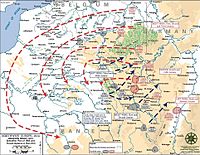
The Ulm campaign is seen as one of the greatest examples of a strategic turning movement. For example, in his book Harper Encyclopedia of Military History, Dupuy wrote: "Ulm was not a battle; it was a strategic victory so complete and so overwhelming that the issue was never seriously contested in tactical combat. Also, This campaign opened the most brilliant year of Napoleon's career. His army had been trained to perfection; his plans were faultless".
Historians often look at the campaign from a broad strategic view. But actual fights were common and important. The big victory at Ulm is also thought to be a result of the long training. The Grande Armée received this training at the Boulogne camps. The Grande Armée carried little baggage. They invaded enemy land during harvest time. They marched much faster than the Austrians expected.
The campaign showed how useful the Corps d'Armée system was. Corps became the basic building block for major wars in the 19th and 20th centuries. A typical corps might have three infantry divisions. It also had a light cavalry group for scouting and extra artillery. Their larger size allowed them to fight without help for long periods, like Ney did. Their strength allowed them to spread out and get food from local areas. The French needed only about one-eighth of the transport used by other armies at the time. This gave them amazing speed and flexibility. Earlier invasions of southern Germany by Marlborough and Moreau covered a small area. But the Grande Armée invaded in 1805 across a front that was 100 kilometers (60 miles) wide. This completely surprised the Austrians. It made them underestimate how serious the situation was.
Sources



